The African American Experience
Icons
This following group of images, in chronological sequence, represents the many celebrated African Americans who have participated in events in New York City's parks.
Click a thumbnail to view an image. Once a larger image appears, click it to advance to the next photo.
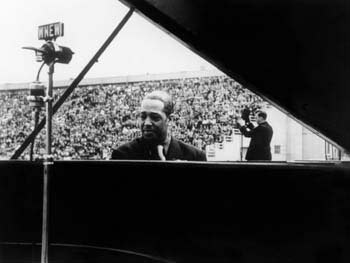
Duke Ellington, Randall's Island, May 29, 1938
Smithsonian Institution/Frank Driggs Collection, Ellington ArchiveOn this day the famous and esteemed Ellington Orchestra was one of 25 bands that performed at the Municipal Stadium on Randall's Island in what was billed as the “Carnival of Swing.”
When Ellington broke into his rendition of “Diminuendo and Crescendo in Blue,“ two little girls from Brooklyn were said by the New York Times to break into a Lindy–hop on the cinder running track, “only to suffer immediate suppression at the hands of a police sergeant.”
The enthusiastic crowd of more than 23,000 swelled and swayed to the music, and encouraged performers with cheers of “Jive it cats,” “Floy foy”, “Killer–diller,” and “Get in the groove.” Profits from the concert totaling $13,700 were raised for the hospital of Local 802, American Federation of Musicians. In 1997, a sculpture of Ellington by Robert Graham was erected at the northeast corner of Central Park.
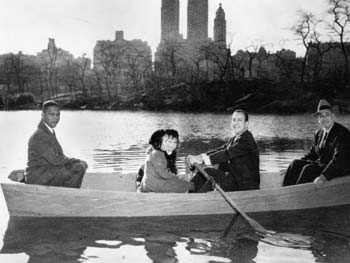
Hulan Jack, Mayor Wagner, Commissioner Moses, Loeb Boathouse Dedication, Central Park, March 12, 1954
New York City Parks Photo Archive, Neg. 28778.2Hulan Jack (1905–1986) was born in St. Lucia in the West Indies, and his family settled in New York City. Dropping out of high school, he went to work as a janitor for the Peerless Paper Box Company, and later rose to the position of vice president of the company.
An active member in local Democratic politics, he was elected to the State Assembly from his Harlem district in 1940 and was re-elected six times before winning the post of Manhattan Borough President in 1953.
He was the first African American to hold this position, and said to be the highest-ranking Black official in the United States. In 1960, during his second term as borough president, he was tried and convicted on charges of bribery and conspiracy to obstruct justice, bringing an abrupt end to his political career.
In this picture, on the occasion of the Loeb Boathouse dedication, Jack is seated in a rowboat on the lake with Mayor Robert F. Wagner and Parks Commissioner Robert Moses.
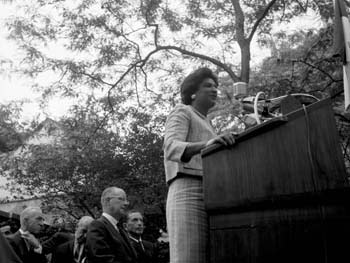
Constance Baker Motley, Delacorte Clock Dedication, Central Park, June 24, 1965
Daniel McPartlin/New York City Parks Photo Archive, Neg. 32465–16 (vertical crop)Born in New Haven, and a graduate of New York University (1943) and Columbia Law School (1946), Constance Baker Motley was a trailblazing African American woman.
After obtaining her law degree she joined the N.A.A.C.P. Legal Defense and Education Fund, where she worked with future Supreme Court justice Thurgood Marshall.
During this time, she drafted the original complaint in the landmark civil rights case Brown versus Board of Education and was also the first African American woman to argue a case before the Supreme Court of the United States.
Indeed, as an African American woman her life was characterized by “firsts”: New York State Senator (1964), Manhattan Borough President (1965), and Federal judge (1966). Here, in her capacity as Manhattan Borough President, she is seen delivering remarks at the dedication of the musical clock, a gift of publisher and philanthropist George Delacorte that has delighted several generations of New Yorkers.
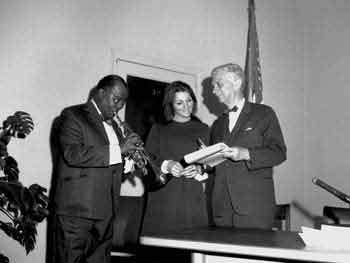
Louis Armstrong, Judy Collins and August Heckscher, the Arsenal, Central Park, April 25, 1967
New York City Parks Photo Archive, Neg. 36070.6Jazz legend Louis “Satchmo” Armstrong blows his horn, as he joins folk–rock great Judy Collins and the parks commissioner to announce the summer park concert series produced by Ron Delsener and sponsored by Rheingold Breweries. Armstrong spent the last decades of his life in Corona, Queens, where his house is today preserved as a museum. One of the tennis stadia at the United States Tennis Center, as well as a park and recreation center in Queens, are named for him.
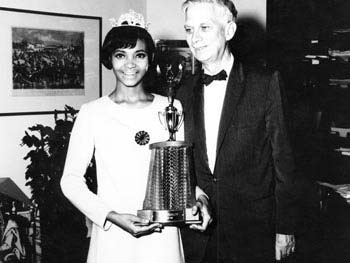
Miss Harlem and Parks Commissioner Heckscher, the Arsenal, Central Park, September 5, 1967
New York City Parks Photo ArchiveHeld at Lasker Rink on December 31, 1967, the Miss Harlem contest was the culminating event of the summer–long Harlem Cultural Festival sponsored by the City's Parks, Recreation and Cultural Affairs Administration.
Jennifer Andrews, the winner, is shown here holding her trophy alongside Commissioner Hecksher. The “New York Beat” column of Jet magazine described Ms. Andrews in decidedly unpolitically–correct terms as a “most ?'luscious–looking' lass.”
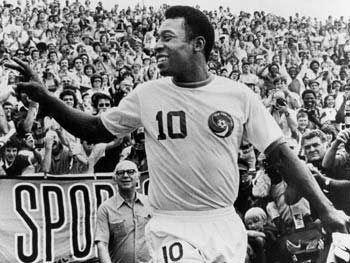
Pele, Downing Stadium, Randall's Island, 1975
Collection of Clive ToyeAfter having retired from a triumphant career in Brazil as the world's greatest soccer player, Pele (Edson Arantes do Nasimiento) signed a three–year contract with the New York Cosmos.
His debut at an exhibition game (which ended in a 2–2 tie) between the Cosmos and Dallas Tornados attracted a capacity crowd of over 21,000 fans and 300 foreign journalists to Downing Stadium.
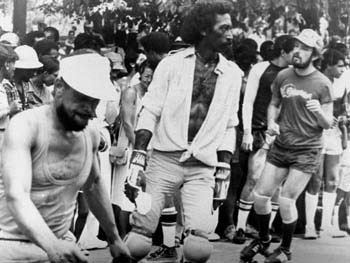
Frankie Crocker, Dead Road, Central Park, circa 1979
Malcolm Pinckney/New York City Parks Photo ArchiveIn the late 1970s, the Dead Road (located to the west of the Central Park Bandshell) became the venue for spontaneous disco roller dancing.
The legendary Frankie Crocker, WBLS disc jockey and Rock and Roll Hall of Famer, is captured at this “scene.”
To this day, the locale draws large weekend crowds, including many foreign tourists eager to see the latest moves of hip New Yorkers.
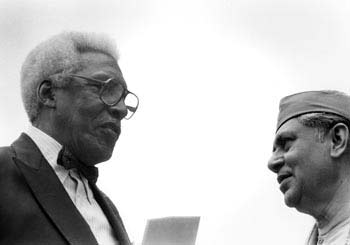
Bayard Rustin and Indian Participant, Gandhi Sculpture Dedication, Union Square Park, October 2, 1986
Calvin Wilson/ New York City Parks Photo Archive, Neg. 60057–2Bayard Rustin (1912–1987) was a leading 20th–century civil rights activist. He helped to form the Congress on Racial Equality (CORE) in 1942, a pacifist organization modeled after the principles of non–violent resistance of Indian independence leader Mohandas Gandhi.
Also around this time, he helped organize the Free India Committee of the Fellowship of Reconciliation. Inspired by early Black labor organizer A. Phillip Randolph, Rustin became active in the Civil Rights movement of the 1950s led by Dr. Martin Luther King Jr. In 1963, he was a principle organizer of the March on Washington for Jobs and Freedom, at which Dr. King delivered his famous “I Have a Dream” speech
The next year he founded the A. Phillip Randolph Institute, an organization dedicated to civil rights and social justice. Late in life, Rustin was an outspoken advocate for gay and lesbian rights, and a year before his death delivered the keynote speech at the Gandhi sculpture unveiling in Union Square Park. Rustin, who was joined at this event by Gandhi's grandson and great grand-nephew, is honored by a marker in Ralph Bunche Park opposite the United Nations.
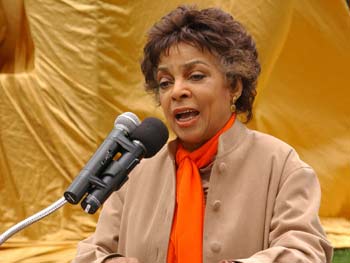
Ruby Dee, Ellison Memorial Dedication, Park, May 1, 2003
Spencer Tucker/New York City Parks Photo ArchiveAt the unveiling of Invisible Man: A Memorial to Ralph Ellison, stage and screen actress Ruby Dee gave a dramatic reading of passages from Ellison's most famous novel.
Dee also performed at a fundraiser to help sponsor this important site–specific commemorative artwork that is situated at 150th and Riverside Drive next to the apartment building in which Ellison lived.
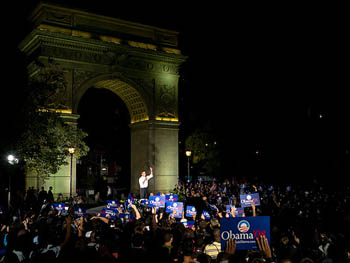
Barack Obama Campaign Rally, Washington Square Park, September 27, 2007
Photo by Aaron Lee Fineman, www.aaronleefineman.comWhile on the campaign trail in his successful bid for the presidency, Barack Hussein Obama staged a campaign rally in Washington Square Park before a crowd estimated at 15,000 persons.
Behind him is the famous arch on which is inscribed the words from Washington's speech at the Constitutional Convention of 1787: “Let us raise a standard to which the wise and honest can repair. The event is in the hand of God.”